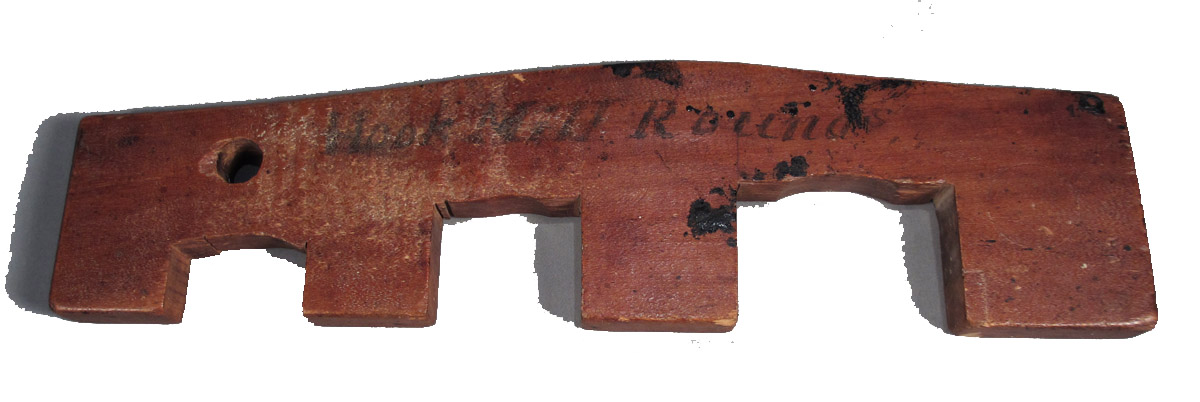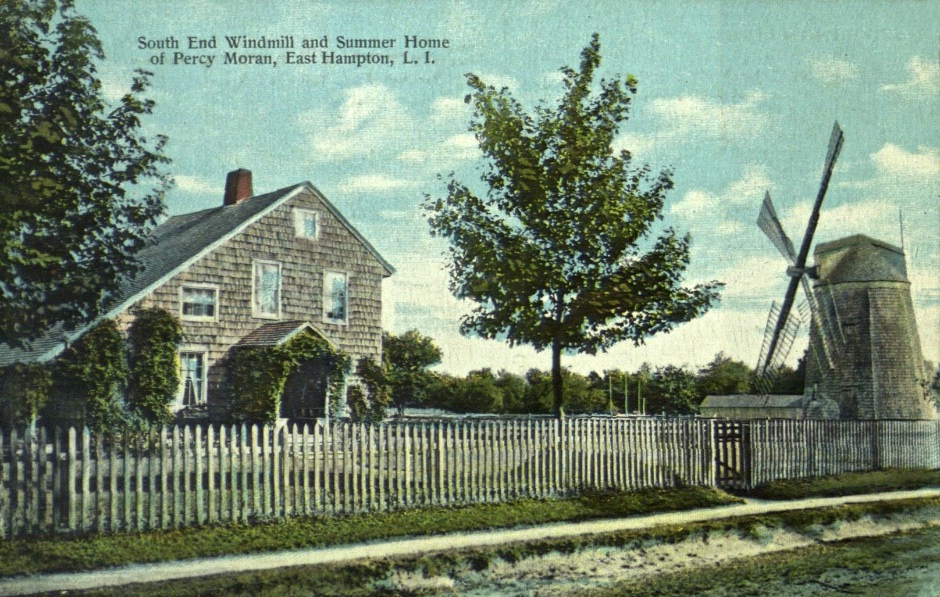The drop in gradient of most streams on Long Island was insufficient to generate enough energy to run water-powered mills. Turning to the abundant alternate sources of energy in wind and tide, Long Island residents called upon the Dominy family to build and repair several mills. Between 1795 and 1810, Nathaniel Dominy V built six wind-powered gristmills, three wind-powered sawmills, and one fulling mill. Four of these mills survive in East Hampton today.
(Above) Edward Lamson Henry, "Old Hook Mill, East Hampton," 1881. Oil on Canvas. Smithsonian American Art Museum.


Nathaniel Dominy V constructed the gears necessary to operate the windmills, including mill cogs and rounds. To do that, he needed accurate measurement tools, which he also made in his workshop.
Mill cog Possibly Charles Mulford Dominy East Hampton, New York; about 1939 Maple, iron Gift of Robert F. Trent in memory of Samuel Chamberlain 1993.62
Gauge for measuring wooden mill cogs and rounds Probably Nathaniel Dominy V East Hampton, New York; about 1810. Museum purchase with funds provided by Henry Belin du Pont 1957.26.275
Hook Mill
In 1806 Nathaniel V built a wind-powered gristmill in the East Hampton enclave of Sandy Hook (later truncated to “The Hook”), where it remained in continuous operation until 1908. In 1939 his great-grandson, Charles Mulford Dominy, restored the structure for the town, ensuring its preservation as an important local landmark. In 1940, the Historic American Buildings Survey catalogued the Hook windmill. Their photos demonstrate the skill and competence of Nathaniel Dominy V, who would go on to build two more windmills during his lifetime.
Image: Historic American Engineering Record (Library of Congress)

Pantigo Mill
Samuel Schellinger built the Pantigo Windmill for Huntting Miller in 1804. Nathaniel Dominy V made frequent repairs to the mill, including one for Miller in 1821 and another for subsequent owner Captain William Hedges in 1834. Dominy charged Hedges to "put in shaft Cogs and Rounds." In 1865, Nathaniel Dominy VII purchased the mill and attempted to continue operating it in 1878. The following year, a storm destroyed many of the parts and Dominy ceased his efforts. The mill was moved from its original location on Pantigo Road to its current location behind the historic "Home Sweet Home" house in 1917. The Village of East Hampton acquired the structure in the 1970s and have made major repairs.
Image: Historic American Engineering Record (Library of Congress)

Gardiner Mill
Nathaniel Dominy V built Gardiner Mill for John Lyon Gardiner in 1804 at a cost of more than 528 pounds. It operated only a short distance away from Pantigo Mill (in its original location) until 1900. The property retains its historic architecture and nine acres of farmland, which remain farmed by a descendent of the original owner. According to surveyors from the Historic American Engineering Record, Dominy's repairs to the mill in 1815 represent some of the most advanced millwriting technology found in a Long Island windmill.
Image Credit: Harvey Ginsberg Postcard Collection, Courtesy of East Hampton’s Long Island Collection.

Shelter Island Mill
In 1810, Nathaniel Dominy sent detailed instructions for the building of a mill to Moses Cleveland of Southhold, Long Island. Built in 186 days, it operated continuously in its original location until 1840 when it was purchased by Joseph Congdon and moved to Shelter Island. It replaced an older mill burned down and gradually fell into disrepair after 1855. Restored in the 1870s by Lillian Horsford, the mill remained in the center of town until it was once again moved to the nearby grounds of Sylvester Manor in 1926 where it remains today.
Image: Historic American Engineering Record (Library of Congress), c.1968.

